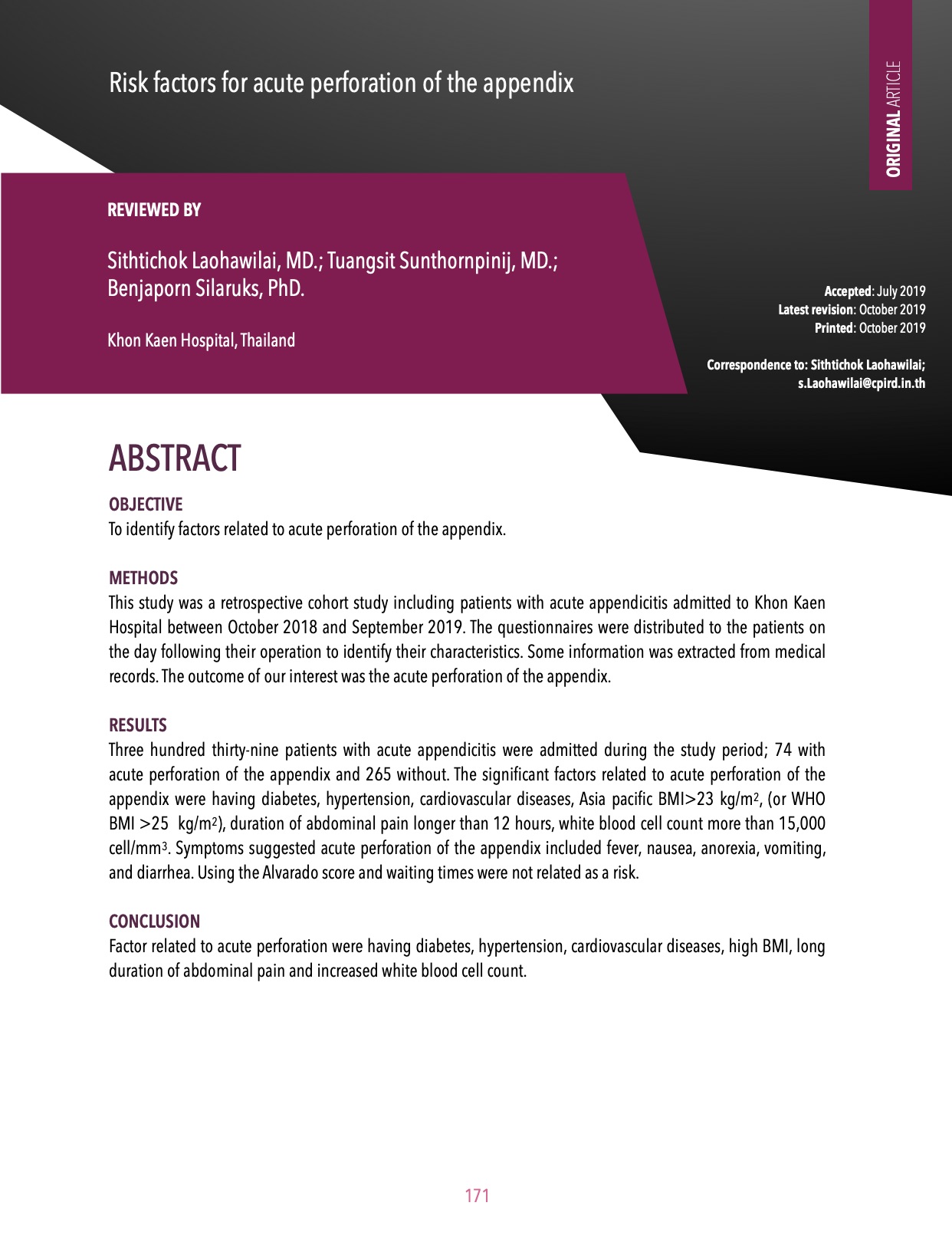Risk Factors for Perforated Appendicitis in a Tertiary Hospital
Abstract
Abstract
AIMS
To identify factors related to perforated appendicitis in a tertiary hospital.
METHODS
This study was a retrospective cohort study with appendicitis patient admitted to Khon Kaen Hospital between October 2018 to September 2019. The questionnaires were distributed to the patients the day following their operation to identify the characteristics. Some information was extracted from medical records.
RESULTS
Three hundred thirty nine appendicitis patients admitted from October 2018 to September 2019.There were 265 patients with acute appendicitis and 74 perforated appendicitis. The significant factors related to perforated appendicitis were patients underlying diseases, Asia pacific BMI>23Kg/m2, WHO BMI >25 Kg/m2, duration of abdominal pain longer than 12 hours, white blood cell count more than 15000/mL. Patients symptoms suggest the clinical of appendicitis with perforation such as fever, nausea, anorexia, vomiting and diarrhea. Alvarado score and waiting times not related as a risk.
CONCLUSION
Factor related to perforated appendicitis were underlying diseases, obesity, duration of abdominal pain, level of white blood cell counts. some symptoms such as fever, nausea, anorexia, vomiting and diarrhea suggested patients having perforated appendicitis.
References
Williams GR. Presidential Address: a history of appendicitis. With anecdotes illustrating its importance. Ann Surg 1983; 197:495.
Fitz RH. Perforating inflammation of the vermiform appendix with special reference to its early diagnosis and treatment. Am J Med Sci 1886; 92:321.
Addiss DG, Shaffer N, Fowler BS, Tauxe RV. The epidemiology of appendicitis and appendectomy in the United States. Am J Epidemiol 1990; 132:910.
Körner H, Söndenaa K, Söreide JA, et al. Incidence of acute nonperforated and perforated appendicitis: age-specific and sex-specific analysis. World J Surg 1997; 21:313.
Douglas Smink, MD, MPH,David I Soybel, MD. Management of acute appendicitis in adults; https://www.uptodate.com/contents/management-of-acute-appendicitis-in-adults?search=appendicitis%20adult&source=search_result&selectedTitle=1~150&usage_type=default&display_rank=1
Gadomski A, Jenkins P. Ruptured appendicitis among children as an indicator of access to care. Health Serv Res 2001; 36: 129–142.
Buckley RG, Distefan J, Gubler KD, Slymen D. The risk of appendiceal rupture based on hospital admission source. Acad Emerg Med 1999; 6: 596–601.
เอกสารตรวจราชการเขต 7
Aroui H, Kalboussi H, El Ghali A, Kacem I, Maoua M, Maatoug J, Taieb D, Hamila F, Mrizak N,The effect of environmental factors on the incidence of perforated appendicitis. Ann Ital Chir. 2018;89:431-437.
N. Sicard, Non‐patient factors related to rates of ruptured appendicitis, BJS,Volume94, Issue2 February 2007 Pages 214-221
Temple CL, Huchcroft SA, Temple WJ. The natural history of appendicitis in adults. A prospective study. Ann Surg 1995; 221:278.
Pogorelić Z, Rak S, Mrklić I, Jurić I., Prospective validation of Alvarado score and Pediatric Appendicitis Score for the diagnosis of acute appendicitis in children., Pediatr Emerg Care. 2015 Mar;31(3):164-8. P
Peyvasteh M, Askarpour S, Javaherizadeh H, Besharati S. MODIFIED ALVARADO SCORE IN CHILDREN WITH DIAGNOSIS OF APPENDICITIS.Arq Bras Cir Dig. 2017 Jan-Mar;30(1):51-52.
Burjonrappa S, Rachel D., Pediatric appendectomy: optimal surgical timing and risk assessment.Am Surg. 2014 May;80(5):496-9.
Stevenson MD, Dayan PS, Dudley NC, Bajaj L, Macias CG, Bachur RG, Sinclair K, Bennett J, Mittal MK, Donneyong MM, Kharbanda AB; Time From Emergency Department Evaluation to Operation and Appendiceal Perforation.Pediatrics. 2017 Jun;139(6).
Taweesuk P, Sithtichok L, Sasithorn M, Outcomes of Treatment for Appendicitis by using Alvarado Score in Khon Kaen Hospital, Thailand. Udonthani Udonthani Hospital Medical Journal Hospital Medical Journal, Vol.26 No.2 May - August 2018.
Nascimento RR, Souza JCG, Alexandre VB, Kock KS, Kestering DM. Association between the Alvarado score and surgical and histopathological findings in acute appendicitis. Rev Col Bras Cir. 2018 Oct 18;45(5):e1901. doi: 10.1590/0100-6991e-20181901.



